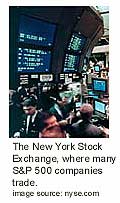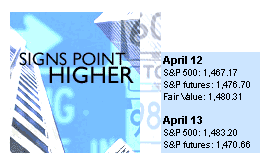NEW YORK (CNNfn) - Business jargon comes and goes, moving like any fad to the commonplace from the obscure and back to obscurity.
Remember the corporate raider? And then there were junk bonds.
The latest entry: "fair value," a phrase fast gaining currency in the world of business journalism.
Investors itching to know how the stock market might open get fair value quotes alongside financial staples like the dollar, the 30-year bond and the price of light sweet crude.
But what is fair value? And why does it matter? Read on.
Predicting the futures
Understanding the term begins with getting a handle on the relationship between a futures contract -- in this case the S&P 500 futures contract -- and the underlying commodity that the contract's value is derived from. In this case that's the S&P 500 index of large company stocks such as Microsoft (MSFT: Research, Estimates), General Electric (GE: Research, Estimates) and Merrill Lynch (MER: Research, Estimates).
 Whether it's pork bellies, interest rates, or the S&P 500, buying or selling a futures contract represents making a bet on the future direction of the underlying commodity. The Chicago Mercantile Exchange, the big futures market where the S&P contract trades, even allows institutions to take positions on the weather in nine American cities. Whether it's pork bellies, interest rates, or the S&P 500, buying or selling a futures contract represents making a bet on the future direction of the underlying commodity. The Chicago Mercantile Exchange, the big futures market where the S&P contract trades, even allows institutions to take positions on the weather in nine American cities.
An agreement to buy or sell the S&P futures amounts to a bet on how the index of stocks will behave over time. And like any financial security, its value changes moment to moment based on what traders will pay for it.
Launched in 1982 by the Chicago Mercantile Exchange, the contracts expire in March, June, September and December, with the most active trading done in the near-month contract.
And because the contract's terms are settled at a future date, the price of the contract generally leads the price of the index on expectations that S&P 500 stocks will do what they have done in the years past: rise.
So too with another contract emerging as a pre-market indicator: the Nasdaq 100 futures contract. The derivative of the 100 biggest stocks in the Nasdaq market also trades at the Chicago Mercantile Exchange.
 Jack Cafferty, anchor of CNNfn's Before Hours, recently reported on both on the Nasdaq and S&P contracts, fair value, and their impact on the upcoming market open. (390K WAV) (390K AIFF) Jack Cafferty, anchor of CNNfn's Before Hours, recently reported on both on the Nasdaq and S&P contracts, fair value, and their impact on the upcoming market open. (390K WAV) (390K AIFF)
Cash is king
So, the price of the futures generally leads the price of the index. But now the relationship between the S&P 500 and its futures contract gets more complicated.
Here's how: The theoretical cost of owning all 500 stocks in S&P 500 will always be different than the cost of owning an S&P futures contract, which has no cost beyond its face value.
This difference comes from two factors. First, if you bought all of the stocks in the S&P 500, you'd have to fully finance the purchase -- a huge undertaking -- or borrow from your broker at the current interest rate.
Those who calculate fair-value -- big investment banks and brokerages -- factor in this constantly changing borrowing cost.
Second, if you owned the stocks in the index, you'd receive dividends. To varying degrees, S&P companies may pay their shareholders dividends, but futures don't distribute earnings to shareholders. They don't have earnings or shareholders.
So, determining the fair value relationship between the S&P 500 futures contract and the underlying S&P 500 index requires adding the cost of borrowing the money to buy the S&P stocks while subtracting the gain those stocks pay in dividends.
Everyday, CNNfn calls trading desks that calculate this figure after the market closes. If they say, for example, that fair value is "plus 10," the futures contract needs to be 10 points above the cash index's close the previous day to be at its fair value relationship to cash. S&P futures trade nearly 24 hours a day. So if, before the stock market opens, futures are trading above their fair value relationship to where the S&P closed the previous day, stocks are likely to open higher.
Fair value in action
Consider a real-life example. On Wednesday, April 12, the S&P 500 index closed at 1,467.17
S&P futures closed higher, at 1,476.70.
Fair value for the futures, according to those who calculate the figure, was 1,480.31, or nearly plus four.
 On the morning of April 13, the futures ended their overnight trading session 1,483.20. (That session ends at 9:15 a.m., ET) That's 2.89 points above their fair value relationship to cash. On the morning of April 13, the futures ended their overnight trading session 1,483.20. (That session ends at 9:15 a.m., ET) That's 2.89 points above their fair value relationship to cash.
So market forecasters called for the stock market to open higher.
Sure enough, at 10:10 a.m. the S&P 500 index was up 3.49 to 1,470.66.
Typically, one point above or below fair value equals 8 points on the Dow Jones industrial average as trading begins. This 1-to-8 relationship reflects the ratio between the value of the S&P 500 index and the Dow.
At 10:10 a.m., ET the Dow was up 15.20 points, near the 23.12-point gain that the fair value formula anticipated.
The arbitrageurs
There's another way fair value has relevance. During the trading day, when the S&P 500 index and the futures trade simultaneously, the S&P 500 futures contract usually moves in a fair-value relationship to the S&P 500 index.
But occasionally, the S&P 500 futures contract may trade above or below its fair value relationship to the S&P 500 index.
When this happens, people called arbitrage traders -- who look to take advantage of temporary price disparities in the market -- will buy or sell in order to make money when the S&P 500 futures contract returns to its historic relationship to the S&P 500.
Here's an example: If futures trade over their fair value to the index price, a trader would agree to sell the contract at a future date, believing its price will fall.
If this fall happens, the arbitrageur will profit by pocketing the difference between selling the higher-priced contract and buying the cheaper one.
Those buying the contract are called speculators who move in and out of the contracts, making or losing money based on the accuracy of their bets.
Then there are the hedgers.
A money manager who owns stock in S&P 500 companies, for example, might agree to sell the contract in the future.
This way, if the price of his stock portfolio falls, the manager can guarantee the drop will be offset by the selling the contract, neutralizing the loss.
If the portfolio strengthens, the money manager is also OK. He simply buys an offsetting contract, neutralizing the original futures position. 
|

